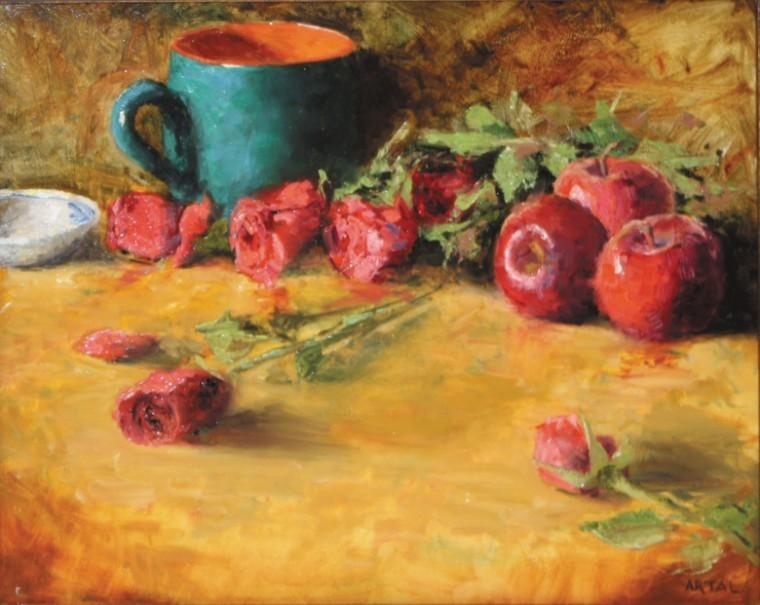From psycholanalysis to still lifes
Published September 28, 2011
Dr. Michal Artal is living proof that getting older can provide an opportunity to pursue our passions to the fullest. If we’re lucky, time and good health will be on our side. And who knows, perhaps by age 66, we’ll enjoy the personal equivalent of a milestone accomplishment such as a one-woman museum art exhibition like Artal has.
“Painting has always been something that relaxes me and that I enjoy,” says Artal, who lives in Ladue but was born and raised in Israel. “My mother was an artist so I grew up with turpentine, varnish, paints and what not. I’m self-taught and took quite a few workshops with some very good artists and suppose I improved over the years. But it was always a hobby to my other work.”
ADVERTISEMENT
Artal’s other work was as a psychiatrist and psychoanalyst, from which she retired three years ago. In 1998, she joined the faculty of psychiatry at St. Louis University, where she was appointed associate professor and residency program director in psychiatry.
She is married to Dr. Raul Artal, a professor and department chair of Obstetrics, Gynecology and Women’s Health at SLU’s School of Medicine. The couple has three adult children and three grandchildren, with another one of the way.
Earlier this month, “Continuing Traditions,” which features 41 of Artal’s still life and landscape oil paintings, opened at SLU’s Museum of Art in Grand Center and continues through Oct. 9. Museum Director Petruta Lipan says she was impressed by Artal’s ability to capture the unique beauty of everyday objects and scenes in her work.
“She handles composition really well. The color and balance in her work has an old-school feel,” Lipan says as she leads a tour of the show. “Some are more impressionistic. What is amazing is that all the objects she paints are objects that are in her house.”
ADVERTISEMENT
In fact, all 41 paintings adorned the walls of the Artal’s home prior to the show. Now they are arranged by themes – objects and fruits, flowers, vegetables, landscapes – in the museum’s various rooms. As we walk among the rooms, Lipan points out the attention Artal pays to every detail, including even choosing the right frame.
“Each has a different frame that goes perfectly with the piece,” she says, explaining that the frame is an extension of the painted work.
Lipan says that she heard about Artal’s paintings through word-of-mouth. “I knew she and her husband worked for the university,” she says. “I suppose I was curious. So I called her and asked if I could see her work.
She adds: “There is no question she has talent. She went into a different profession but kept improving her artistic skills. It was clear to me that the scope and breath of her work was worthy of an exhibition.”
Lipan explains that part of the museum’s mission is to highlight the work of local artists and introduce them to a museum setting. “We want to bring the aspect of their art making into public discussion,” she says. “But to me, what is also so wonderful about Michal’s work is that it is living proof we can have second careers if we choose. She can now pursue this passion without having to worry about making money doing so. She’s an inspiration.”
Michal Artal isn’t so sure about being an inspiration, but she clearly is happy to be painting more regularly. Her home is filled with her artwork, though her husband jokes what currently hangs on the walls are “the rejects” – lesser paintings taking the place of the ones in the museum show. “The walls just didn’t look good with nails and nothing to cover them,” Michal Artal says.
Raul Artal is insistent as we speak that the focus of any story stays on his wife. But that’s hard because his story, too, is so compelling.
He spent his first year of life in the Romanian concentration camp of Bershad in Transnistria during the Holocaust, where his parents worked like slaves and lived in squalor with no food in an overcrowded barn, hiding their baby from German and Romanian guards. “I was not allowed to cry,” he says. “They covered my face with a little pillow.”
He points to the memoir “Ruth’s Journey,” written by fellow Transnistria survivor Ruth Glassberg, as an apt description of the horrific, inhumane conditions that his parents endured. If they were lucky, they would find raw potatoes to eat and pick some cherries from a tree.
Eventually, at the age of 17, he and his parent moved to Israel where Raul met Michal when both served in the Israeli Army. They were married when she was 20 and he was 21.
Both studied medicine in Israel and moved to the United States to complete their residencies. Their careers took them from Cleveland to Los Angeles to upstate New York before moring to St. Louis in the late 1990s.
Michal Artal says she began painting in her mid-thirties as a release from the stresses of medicine. “Being a psychiatrist, and trained in psychoanalysis, you’re very immersed emotionally and intellectually in the other, the story of the patients,” she explains. “Painting was very different. It’s really my own thoughts and emotions and responses to my surroundings. So it’s very rewarding but at the same time very challenging.”
Now in retirement, Michal tries to paint daily, though she jokes that she finds herself amazingly busy even though she is no longer working regular hours. A soft-spoken, gentle woman, she is noticeably thrilled about her first solo show.
“What is the saying?” she asks out loud, straining to remember. “Art cleanses the soul from the dust of every day life.”
Close enough. You get the point.
‘Continuing Tradition’
WHEN: 11 a.m.- 4 p.m. Wednesdays through Sundays, through Oct. 9
WHERE: St. Louis University Museum of Art, 3663 Lindell Boulevard
HOW MUCH: Free
MORE INFO: 314-977-2666 or www.slu.edu
















